If you have done much silver work, then work hardening the silver is something you are probably familiar with. Work hardening is when you have beat, bent, stretched, folded, etc the silver so much that it has lost its flexibility or workability. One example I will give here is I have a piece of shanking material that is too thick, I could solder it as is, but then I would spend a lot of time filing and grinding the metal to size, so in this instance, I roll the piece through my rolling mill to thin the metal to the size I want.
Great! Now I have the shank to the size I want, but for some reason it is very stiff and hard to work. What I have just done is “Work Hardened the metal. Here is a quick science lesson….. What has happened to the metal is the molecules in the silver, which used to be uniform (and happy), have now been flattened and deformed (and stressed). What must be done now is a process called annealing. Annealing is heat treating the metal and rearranging the molecules in a way that makes them less stressed and happy again. (ok, so I am not real scientific).
Here is quick illustration of what I am describing.
Happy Molecules:
Stressed Molecules:
Happy Once Again:
So here is a quick way to anneal your stressed metal
Use a nice “bushy” flame. (Smith Mini Torch)
You will want to turn off your bench light so you can see the metal change colors better. Apply your nice bushy flame to the silver and watch it. Do not get it too hot too fast. Move your flame back and forth and watch the metal for changing color. You want to try to get the silver to change to a very dull pink color. Try to keep that color for 30 seconds or so by moving the heat away and brushing the flame over again. DO NOT get the silver to a glowing red color. If you do this, quench the silver in water and start the process over again.
Now quench your silver in your pickling solution.
Leave it in your pickling solution (I use Sparex) for a few minutes, remove with Copper Tongs
(or plastic tongs
). Never use steel tools to remove metal from pickle, it will destroy the solution and you will notice your silver will start to turn pink….. the solution will start to react with the copper alloy in the sterling, turning your silver pink. If this starts to happen, change your pickling solution.
After a few minutes, remove the silver from the solution, and dip in a mixture of water and baking soda( available at your local grocery store. (approx 1 oz. (shot glass) to 2 cups of water)
The baking soda will neutralize the acid from the pickle and keep from getting on your hand, tools, bench, etc. Always use baking soda/water after your pickle. After that, then dip in clean water.
Now you have happy silver again.
Now, have a “Happy” Day and go make some “Happy Jewelry”!
Doug
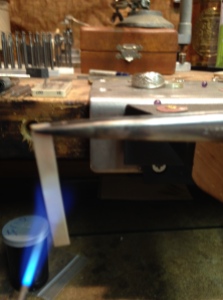
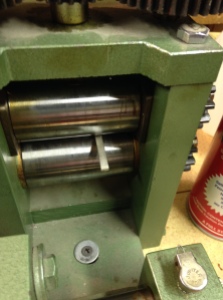



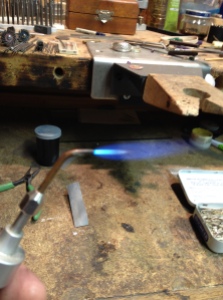
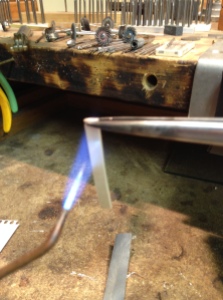
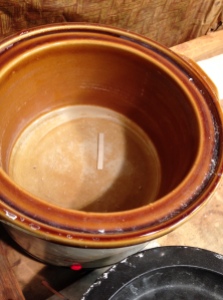

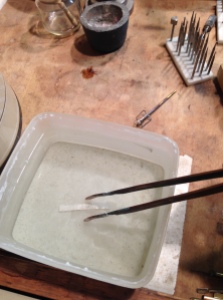

Thanks for your post. I’m concerned about your instruction to quench hot silver directly into the pickle. I was always taught to quench in water and then put the metal into the pickle. Direct quenching results in a micro spray of pickle getting into the air and onto your clothes and skin. If it gets on your skin and you get hot or perspire the pickle will burn your skin. If it gets on your sleeves or clothes you will notice tiny pin holes in your clothes.
Good point, safety first! I have a plastic lid over my pickle and cover it as I put the metal into it. The level of liquid in my pickle is about 1″ or less, unless I am working on larger pieces. I have never gotten burned or ruined clothes, but that is not to say it couldn’t happen. Good point, always be careful.
Im glad that “quenching in pickle” was brought up. I was taught that early on the spray from pickle is unsafe and will never forget it. Thanks for your posts, i look forward to them 🙂
Not only the spray is a problem, quenching in pickle produces harmful vapors that you will inhale, even with a lid ( they get out while you are standing next to your pickle before you can put the lid on). Plus there’s the possibility of acid residue getting “caught” in micropores in the material. Resulting in corrosion over time, even skin irritation in the case of jewelry.
I also wanted to comment that when you put steel or iron in your pickle it is not the sterling that reacts. This triggers an electric reaction in the solution acting as an electroplating bath that deposits the copper ions, that have been dissolved by the pickle in the past and are floating in the solution, on any metal surfaces that are placed in the solution.
Thanks for your comments Lucia.
Wow, so much good stuff in this article! I never knew to add baking soda to my wash-out water bowl, thank you!
Thanks Stephanie!
Using steel tweezers doesn’t destroy the pickle, all it does is cause the copper that’s dissolved in it (which comes from either Sterling silver or other alloys with copper in them being in the pickle) to plate out on to the silver when you touch your silver with them. No need to throw it out, it’s perfectly fine. Nothing in it has changed.
Unless you don’t want your silver copper plated…..
Once you stop using the steel tweezers everything is fine again, you just go back to using your copper ones. The steel tweezers only affect the silver while you’re using them ie touching the silver, they don’t change the pickle in any way. Touching the silver with the steel creates an electroplating reaction, that’s all.
You can remove the pink copper plating by taking some hot pickle in a separate container and adding hydrogen peroxide to the pickle. Drop the silver in and the copper plating will disappear. Remove the silver from the peroxide pickle. There are times when one might want to copper plate some silver ie copper plating granules for granulation.Just put a piece of binging wire into the pickle, plate the granules and then remove the binging wire. The pickle will be fine as long as there is no longer any iron in the pickle pot.
Pingback: Day 16 V-Bezel Making | JewelryMonk
Pingback: Day 17 V-Bezel Pendant | JewelryMonk
Pingback: Day 31 Back to Soldering Basics | JewelryMonk
Pingback: Making a Twisted Wire Two-Toned Band (Part 2) |
Hey, thanks for this! This advice came right on time, as I had some annealing to do on a heavy bracelet I’d been working on in my jewelry class.
That is good to hear Jen. Anneal-on!
Hi Doug, curious about what happens if you get the metal a glowing red color instead of dull pink. What does that do to the metal? Thanks.
DaleLynn, metal heated to a glowing red color, though now soft, will be more apt to produce an orange peel surface when bent, due to the resulting large crystal size.
Doug
Comments are closed.